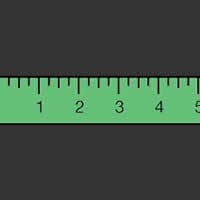
Metric length units are used across the majority of the world, with the metre being the base unit of length. Over the years the metre has stayed very similar in length despite its definition varying significantly. The first definition was as 1 ten-millionth of the meridian of the earth, following this a prototype metre bar was produced and when the measurement of the meridian of the earth was found to be slightly inaccurate, instead of changing the prototype metre, the existing protoype metre became the definition. Following this in 1960 the definition was made in terms of the wavelength of light from a specified transition in krypton-86 and in 1983 the definition was made as the length traveled by light in a vacuum in a specific time interval. More detail on the history of the metre can be found here.
Other metric length units such as the kilometre, centimetre and millimetre are defined in relation to the metre using standard metric prefixes.
Table of Metric Length Units
| Unit | Abbreviation | As Metres | Useful Information |
| micrometre | μm | 0.000001 | Also known by the non SI name micron |
| millimetre | mm | 0.001 | Often the smallest unit on a metric ruler |
| centimetre | cm | 0.01 | |
| decimetre | dm | 0.1 | Rarely used |
| metre | m | 1 | Base length unit of the SI metric system |
| decametre | dam | 10 | Rarely used |
| hectometre | hm | 100 | Rarely used |
| kilometre | km | 1,000 | Used on road signs in countries using metric measurements |
| megametre | Mm | 1,000,000 | Rarely used |
Imperial length units are the second most commonly used set of length and distance units in the world today, having spread during the years of the British Empire to the US, Canada, Australia, South Africa and many smaller nations. Most have now adopted the metric system including Britain for most units (the mile is still used in the UK for road signs).
The British imperial units were established at different dates with yards, feet and inches dating from the late thirteenth century and the mile being standardised in the late 16th century during the reign of Elizabeth I. Before this the mile was of different lengths in different parts of Britain with Scotland and Ireland both having their own miles.
Despite Britain having formally adopted the metric system most people in Britain will still give their height in feet and inches, as will most older people in British Commonwealth countries such as Canada, Australia and New Zealand.
Table of Imperial Length Units
| Unit | Abbreviation | As Metres | Useful Information |
| thou | th | 0.0000254 | 1 thousandth of an inch, hence the name |
| inch | in | 0.0254 | 1/12th of a foot |
| foot | ft | 0.3048 | Height is measure in feet and inches in the US and UK |
| yard | yd | 0.9144 | Closest imperial unit in length to the metre |
| chain | ch | 20.1168 | Length of a cricket pitch |
| furlong | f | 201.168 | 1/8th of a mile, sometimes abbreviated to fur |
| mile | mi | 1,609.344 | 1760 yards, often abbreviated to m in the UK |